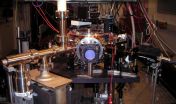(Press-News.org) Scientists from the University of Sheffield have discovered MRI scanners, normally used to produce images, can steer cell-based, tumour busting therapies to specific target sites in the body.
Magnetic resonance imaging (MRI) scanners have been used since the 1980s to take detailed images inside the body - helping doctors to make a medical diagnosis and investigate the staging of a disease.
An international team of researchers, led by Dr Munitta Muthana from the University of Sheffield's Department of Oncology, have now found MRI scanners can non-invasively steer cells, which have been injected with tiny super-paramagnetic iron oxide nanoparticles (SPIOs), to both primary and secondary tumour sites within the body.
This targeted approach is extremely beneficial for patients as it dramatically increases the efficiency of treatment and drug doses could potentially be reduced - helping to alleviate side effects.
Revolutionary cell-based therapies, which exploit modified human cells to treat diseases such as cancer, have advanced greatly over recent years. However, targeted application of cell-based therapy in specific tissues, such as those lying deep in the body where injection is not possible, has remained problematic.
The new research suggests MRI scanners are the key to administering treatments directly to both primary and secondary tumours wherever they are located in the body.
The study, published today (date) in Nature Communications shows that cancer mouse models injected with immune cells carrying SPIOs and armed with the cancer killing oncolytic virus (OV) which infects and kills cancer cells, showed an 800 per cent increase in the effects of the therapy.
Dr Munitta Muthana, from the University of Sheffield, said: "Our results suggest that it is possible to use a standard MRI scanner to naturally deliver cell-based therapies to both primary and secondary tumours which would normally be impossible to reach by injection.
"This not only increases the therapeutic efficacy but also decreases the risk of unwanted side effects.
"The beauty of using the MRI scanner to administer the therapy is that you can also use it for its original purpose providing a real-time image-guide to ensure the treatment has gone where it is needed."
INFORMATION:
The study, which was funded by the Medical Research Council (MRC), was conducted in collaboration with University College London and University College London Comprehensive Cancer Imaging Centre and the University of Florida.
Notes to Editors
University of Sheffield
With almost 26,000 of the brightest students from around 120 countries, learning alongside over 1,200 of the best academics from across the globe, the University of Sheffield is one of the world's leading universities. A member of the UK's prestigious Russell Group of leading research-led institutions, Sheffield offers world-class teaching and research excellence across a wide range of disciplines. Unified by the power of discovery and understanding, staff and students at the university are committed to finding new ways to transform the world we live in. In 2014 it was voted the number one university in the UK for Student Experience by Times Higher Education and in the last decade has won four Queen's Anniversary Prizes in recognition of the outstanding contribution to the United Kingdom's intellectual, economic, cultural and social life. Sheffield has five Nobel Prize winners among former staff and students and its alumni go on to hold positions of great responsibility and influence all over the world, making significant contributions in their chosen fields. Global research partners and clients include Boeing, Rolls-Royce, Unilever, AstraZeneca, Glaxo SmithKline, Siemens and Airbus, as well as many UK and overseas government agencies and charitable foundations.
For further information, please visit http://www.sheffield.ac.uk
The Medical Research Council (MRC)
The MRC is at the forefront of scientific discovery to improve human health. Founded in 1913 to tackle tuberculosis, the MRC now invests taxpayers' money in some of the best medical research in the world across every area of health. Thirty-one MRC-funded researchers have won Nobel prizes in a wide range of disciplines, and MRC scientists have been behind such diverse discoveries as vitamins, the structure of DNA and the link between smoking and cancer, as well as achievements such as pioneering the use of randomised controlled trials, the invention of MRI scanning, and the development of a group of antibodies used in the making of some of the most successful drugs ever developed. Today, MRC-funded scientists tackle some of the greatest health problems facing humanity in the 21st century, from the rising tide of chronic diseases associated with ageing to the threats posed by rapidly mutating micro-organisms. http://www.mrc.ac.uk
For further information please contact: Amy Pullan, Media Relations Officer, University of Sheffield, 0114 222 9859, a.l.pullan@sheffield.ac.uk
To read other news releases about the University of Sheffield, visit http://www.sheffield.ac.uk/news
Women giving birth after undergoing fertility treatment face an increased risk of depression compared to women ending up not having a child following fertility treatment, according to new research from the University of Copenhagen. According to the researchers, this has key implications for fertility treatment in future.
Danish researchers are among the first worldwide to study the risk of developing a clinical depression for women undergoing fertility treatment. The new study shows that women who give birth after receiving fertility treatment are five times more likely ...
Tropical Depression 11E came to an end early today, Tuesday, August 18 when the National Hurricane Center noted that the storm degenerated into a remnant low pressure area. NOAA's GOES-West satellite caught an infrared image of the fizzling system.
At 5 a.m. EDT (2 a.m. PDT/0900 UTC) the National Hurricane Center (NHC) issued the final bulletin on Post-Tropical depression 11E. At that time, the center of Post-Tropical cyclone 11E was located near latitude 24.9 North and longitude 125.6 West. It had fizzled about 1,000 miles (1,610 km) west of the southern tip of Baja ...
Researchers from Ludwig-Maximilians-Universitaet (LMU) in Munich have used computed microtomography (micro-CT) to identify to the species level an exceptionally wellpreserved fossil arthropod from the famous Chengjiang Lagerstätte in China.
Modern imaging methods make it possible to perform detailed, non-invasive studies on the internal structures of irreplaceable fossil specimens. Researchers led by Dr. Yu Liu of LMU's Department of Biology II now demonstrate the power of this approach by using computed microtomography (micro-CT) to investigate a specimen recovered ...
Researchers from the University of Southampton have demonstrated for the first time a new laser cooling method, based upon the interference of matter waves, that could be used to cool molecules.
Our ability to produce samples of ultra-cold atoms has revolutionised experimental atomic physics, giving us devices from atomic clocks (the core of GPS) and enabling a range of quantum devices, including the possibility of a quantum computer.
However, the current technique of cooling atoms down from room temperature to the ultra-cold regime using optical molasses (the preferential ...
Methylmercury, a toxic form of mercury that is readily absorbed from the gastro-intestinal tract and can cause in a variety of health issues, poses a significant threat to marine animals at the top of the food web. A new study confirms that Artic species of these animals have higher concentrations of methylmercury in their tissues compared with animals lower in the food web; however, it also shows similar trends in selenium, which could help play a protective role against the toxic effects of mercury.
"Methylmercury concentrations increased through the food web at greater ...
When a patient is in urgent need of a doctor for illness or injury, expecting that doctor to help is natural.
But a new study , published in Social Psychological and Personality Science, finds that the greater patients' need for medical care, the more likely patients will view their doctors as "empty vessels," devoid of emotions or personal lives of their own; at the same time, those patients expect their physicians to be able to contain the patients' emotions and experiences.
The study is unusual in that most research focuses on the reverse--how physicians view patients.
In ...
Students who have used electronic cigarettes by the time they start ninth grade are more likely than others to start smoking traditional cigarettes and other combustible tobacco products within the next year, according to a new study funded by the National Institutes of Health. E-cigarettes deliver nicotine to the lungs by heating a liquid solution that contains nicotine and other chemicals to produce an aerosol that the user inhales, a process often called "vaping."
The study compared tobacco use initiation among 222 students who had used e-cigarettes, but not combustible ...
August 18, 2015--Individuals near the middle of the social hierarchy suffer higher rates of depression and anxiety than those at the top or bottom, according to researchers at Columbia University's Mailman School of Public Health. Nearly twice the number of supervisors and managers reported they suffered from anxiety compared to workers. Symptoms of depression were reported by 18 percent of supervisors and managers compared to 12 percent for workers. Findings are online in the journal Sociology of Health & Illness.
While social disadvantage related to income and educational ...
A new study indicates that for a 2.5 year period shortly before and during the early years of the Greek economic crisis, the prevalence of overweight and obesity decreased in Greek schoolchildren. This was accompanied by an increase in the prevalence of normal weight children and a slight increase in the prevalence of underweight children.
Because this study coincided with the eruption of the Greek economic crisis, it suggests that the changes may be related to the suboptimal conditions that a significant percentage of the Greek population lived in during that period.
Additional ...
CHAPEL HILL NC - Although metformin was introduced as a treatment for type 2 diabetes nearly 60 years ago and is now the recommended first-line treatment for newly diagnosed patients, researchers still debate precisely how the drug works. Now, a study published online today in Diabetes Care by researchers at the University of North Carolina School of Medicine, Elcelyx Therapeutics, and other leading endocrinologists provides strong evidence that metformin's primary effect occurs in the gut, not the bloodstream. The paper outlines results from phase 1 and phase 2 studies ...


